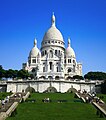Neo-Byzantine architecture

Neo-Byzantine architecture (also referred to as Byzantine Revival) was a
Neo-Byzantine architecture emerged in the 1840s in Western Europe and peaked in the last quarter of the 19th century with the Sacré-Coeur Basilica in Paris, and with monumental works in the Russian Empire, and later Bulgaria. The Neo-Byzantine school was active in Yugoslavia in the interwar period.
Russian Empire
True Byzantine art, popularized by
The reign of
-
Naval Cathedral, Kronstadt
-
The Kazan church,St. Petersburg
-
Ioannovsky Convent, St. Petersburg
-
Exaltation of the Cross Cathedral at St. Nicholas Monastery, Verkhoturye
-
New Afon
-
Nativity Cathedral, Riga
-
St. Michael the Archangel Church, Kaunas
-
The church of theOur Lady of the Sign), Vilnius
-
The Orthodox Church in Białowieża
Southeastern Europe
Bulgaria
-
Faculty of Theology Sofia, Sofia University
-
The Sofia Seminary
-
The Palace of the Holy Synod of the Bulgarian Patriarchate, Sofia
-
St. Nedelya Cathedral Churchat night, Sofia
-
St. Demetrius Cathedral, Vidin
-
St. Nikolay of Sofia church, Sofia
-
Saints Cyril and Methodius Cathedral, Burgas
-
St. Nikolay the Wonderworker church, Stara Zagora
-
Dragalevtsi Monastery (new buildings from 1932) Sofia
-
Regional History Museum Sofia (former Sofia Central Public Mineral Baths)
-
The building of the New Palace in Vrana Palace, Sofia
The Bulgarian Neo-Byzantine style from the end of the 19th and the beginning of the 20th century is often a combination of Byzantine, typical Bulgarian, Eastern Orthodox and Secession/ Art Nouveau/ Modernisme elements.
- Alexander Nevsky Cathedral, Sofia(1882-1912);
- Dormition of the Mother of God Cathedral, Varna (1882-1885);
- Faculty of Theology (Sofia University) (1908-1912)
- Regional History Museum Sofia, former Sofia Central Public Mineral Baths (1913) - the building was designed in the Vienna Secession style, but integrating typically Byzantine, Bulgarian and Eastern Orthodox ornamental elements;
- Sofia Theological Seminary (1902-1914);
- Vrana Palace - the building of the New Palace in "Vrana" is a two-storey massive building, executed in typical Bulgarian style with Secession elements, combined in an elegant Neo-Byzantine spirit.
- Church of St Paraskeva, Sofia (1926-1930)
- St. Nedelya Cathedral Church(10th century, 1933), Sofia
Greece
- Cathedral of Saint Andrew, Patras (1908-1974)
- Church of Saint Panteleimon of Acharnai, Athens (1910-1930)
Romania
-
Entrance of the Laurențiu and Louise Steinebach House (Bulevardul Eroii Sanitari no. 18), Bucharest, by Alfred Popper, 1915-1916[1]
-
Doctor Dobrovici House (Bulevardul Lascăr Catargiu no. 40), Bucharest, by Duiliu Marcu, 1919-1925[2]
-
Doctor Ion and Maria Urlățeanu House (Strada Dumbrava Roșie no. 10), Bucharest, by Alfred Popper, 1922-1923[3]
-
Strada Pictor Constantin Stahi no. 18, Bucharest, by Tiberiu Niga, 1930s[4]
-
Bulevardul Dacia no. 42, Bucharest, unknown architect, 1930s
- Entrance of the Laurențiu and Louise Steinebach House, Bucharest (most of its architectural elements, both exterior the interior, with little Romanian Revival influences)
- People's Salvation Cathedral, Bucharest
- Holy Trinity Cathedral, Sibiu
- Coronation Cathedral, Alba Iulia
- Cathedral of Saints Peter and Paul, Constanța
- Domnița Bălașa Church, Bucharest
- Doctor Ion and Maria Urlățeanu House, Bucharest
- Aleea Alexandru no. 40, Bucharest
- Strada Pictor Constantin Stahi no. 18, Bucharest
- Strada Austrului no. 9, Bucharest
- Bulevardul Dacia no. 42, Bucharest
- Doctor Dobrovici House, Bucharest
Serbia
Serbia's modern sacral architecture got its main impetus from the dynastic burial church in Oplenac which was commissioned by the Karađorđeviċ dynasty 1909.[5] With the arrival of Russian émigré artists after the October Revolution, Belgrade's main governmental edifices were planned by eminent Russian architects trained in Russia. It was King Alexander I who was the patron of the Neo-Byzantine movement.[6] Its main proponents were Aleksandar Deroko, Momir Korunović, Branko Krstić, Grigorije Samojlov and Nikolay Krasnov. Their main contribution were the royal castles on Dedinje, the Church of Saint Sava and the St. Mark's Church in Belgrade. After the communist era ended, Mihajlo Mitrović and Nebojša Popović were proponents of new tendencies in sacral architecture which used classic examples in the Byzantine tradition.[7]
Turkey
Istanbul Agia Triada in Taksim
Ayvalık Agios Georgios (Cınarlı mosque), Agios Ioannis (Saatli mosque), Taxiarchis in Moschonisi/Cunda
Austria

Danish architect
Germany
Earliest examples of emerging Byzantine-
Several Neo-Byzantine-style churches were constructed during the Gründerzeit, for instance, the Sacred Heart Church or the Rosary Basilica, both located in Berlin.
France
One of the earliest examples in France is the enormous Marseille Cathedral, built between 1852 and 1893, and the basilica of Notre-Dame de la Garde, both located in Marseille.
Another example is the Russian orthodox Alexander Nevsky Cathedral in Paris build 1859-1861. [8]
The Saint-Augustin in Paris build between 1860 and 1871 is an example of Eclectic Romano-Byzantine architecture.
A prominent example of Byzantine Revival architecture in France is the Basilica of Sacre-Coeur in Paris, built between 1875 and 1914, based on the original plan of Paul Abadie. It features five elongated domes on the exterior and an interior with mosaics and other art inspired by Byzantine art. [9] Inspired by the former is another excellent example - the Basilica of Sainte-Thérèse, Lisieux completed in 1954.
Great Britain and Ireland
(1885–86) is a notable Irish example.United States
In the United States and elsewhere, the Neo-Byzantine style is often seen in
The Basilica of the National Shrine of the Immaculate Conception is a large Catholic minor basilica and national shrine located in Washington, D.C., United States of America. The shrine is the largest Catholic church in North America, one of the largest churches in the world,[10] and the tallest habitable building in Washington, D.C.[11][12][13] Its construction of Byzantine Revival and Romanesque Revival architecture began on September 23, 1920, with renowned contractor John McShain and was completed on December 8, 2017, with the dedication and solemn blessing of the Trinity Dome mosaic on December 8, 2017, the Feast of the Immaculate Conception, by Cardinal Donald William Wuerl.[14]
Other notable
Gallery
-
Basilica of Sacre-Coeur, Paris, (1875-1914)
-
The Neo-Byzantine façade of Westminster Cathedral, London
-
Painting of the Neuschwanstein Castle Throne Room
-
Interior of the Sacred Heart Church, Berlin
-
St. Louis, United States
-
St. Francis de Sales Roman Catholic Church in Philadelphia, United States
-
Washington D.C., United States
-
Interior of the Church of Saint Sava
-
Interior of the Rosary Basilica, Berlin
-
Church of St Paraskeva, Sofia, Bulgaria
-
St. George the Conqueror church, Sofia, Bulgaria
-
Church of San Manuel y San Benito, Madrid
-
Christ Church United Methodist, New York City, United States
-
Cenakelkerk, Heilig Landstichting, The Netherlands
-
A historic photochrom print of the Fontaine Guillaume, which literally translates to "William (Wilhelm) Fountain", Istanbul
-
Interior of Church of Our Lady Seat of Wisdom, Dublin
See also
- Romanian Revival architecture – combines Byzantine Revival with Art Nouveau and others
References
- ISBN 978-973-1872-51-3.
- ISBN 978-973-0-23884-6.
- ISBN 978-973-1872-51-3.
- ISBN 978-606-081-135-0.
- ISBN 978-86-7025-694-1, S. 87.
- ISBN 978-86-7025-694-1, S. 62.
- ^ Aleksandar Kadijević 2016: Between Artistic Nostalgia and Civilisational Utopia: Byzantine Reminiscences in Serbian Architecture of the 20th Century. Lidija Merenik, Vladimir Simić, Igor Borozan (Hrsg.) 2016: IMAGINING THE PAST THE RECEPTION OF THE MIDDLE AGES IN SERBIAN ART FROM THE 18TH TO THE 21ST CENTURY. Ljubomir Maksimovič & Jelena Trivan (Hrsg.) 2016: BYZANTINE HERITAGE AND SERBIAN ART I–III. The Serbian National Committee of Byzantine Studies, P.E. Službeni glasnik, Institute for Byzantine Studies, Serbian Academy of Sciences and Arts. Hier S. 177 (Academia:PDF)
- ^ Base Mérimée: Cathédrale orthodoxe Saint-Alexandre-Nevsky, Ministère français de la Culture. (in French)
- ISBN 978-2-7072-0683-1
- ^ "20 Largest Churches in the World". Wander. Archived from the original on 2020-07-28. Retrieved 2020-07-28.
- ^ "Basilica of the National Shrine of the Immaculate Conception". National Shrine. Archived from the original on February 3, 2009.
- ^ "The National Shrine". SkyscraperPage.com. Archived from the original on October 5, 2008. Retrieved July 23, 2011.
- ^ The Washington Monument is a taller structure, (though it stands at a lower elevation) but is not a habitable building.
- ^ Samber, Sharon (December 9, 2017). "After a century, the largest Catholic church in North America is finally complete". USA Today. Retrieved December 10, 2017.










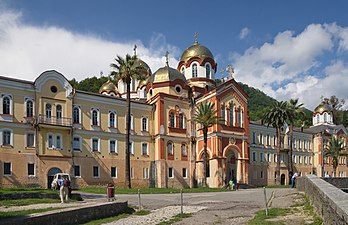









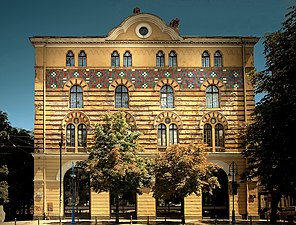
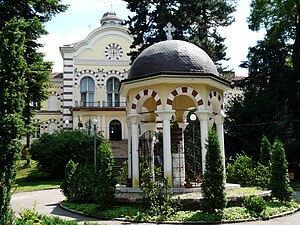



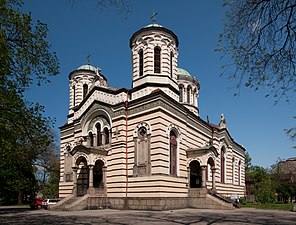



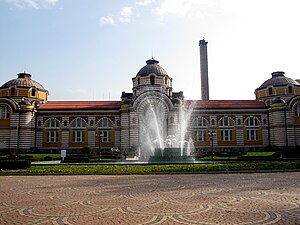

![Entrance of the Laurențiu and Louise Steinebach House (Bulevardul Eroii Sanitari no. 18), Bucharest, by Alfred Popper, 1915-1916[1]](http://upload.wikimedia.org/wikipedia/commons/thumb/4/41/18_Bulevardul_Eroii_Sanitari%2C_Bucharest_%2803%29.jpg/283px-18_Bulevardul_Eroii_Sanitari%2C_Bucharest_%2803%29.jpg)
![Doctor Dobrovici House (Bulevardul Lascăr Catargiu no. 40), Bucharest, by Duiliu Marcu, 1919-1925[2]](http://upload.wikimedia.org/wikipedia/en/thumb/a/a0/40_Bulevardul_Lasc%C4%83r_Catargiu%2C_Bucharest_%2804%29.jpg/286px-40_Bulevardul_Lasc%C4%83r_Catargiu%2C_Bucharest_%2804%29.jpg)
![Doctor Ion and Maria Urlățeanu House (Strada Dumbrava Roșie no. 10), Bucharest, by Alfred Popper, 1922-1923[3]](http://upload.wikimedia.org/wikipedia/commons/thumb/d/d0/10_Strada_Dumbrava_Ro%C8%99ie%2C_Bucharest_%2805%29.jpg/286px-10_Strada_Dumbrava_Ro%C8%99ie%2C_Bucharest_%2805%29.jpg)
![Strada Pictor Constantin Stahi no. 18, Bucharest, by Tiberiu Niga, 1930s[4]](http://upload.wikimedia.org/wikipedia/commons/thumb/9/94/18_Strada_Pictor_Constantin_Stahi%2C_Bucharest_%2801%29.jpg/159px-18_Strada_Pictor_Constantin_Stahi%2C_Bucharest_%2801%29.jpg)


